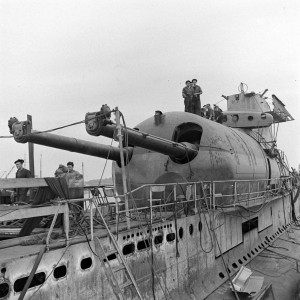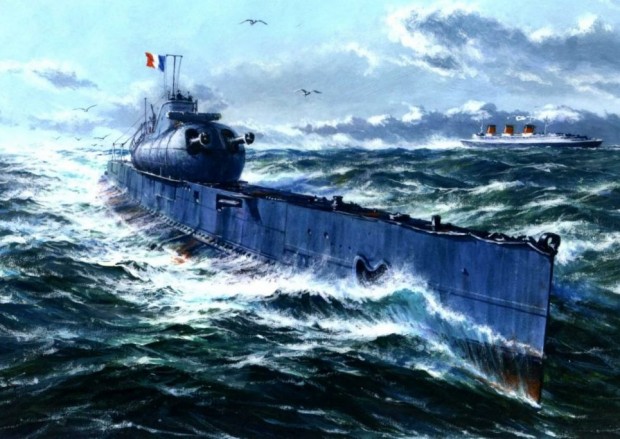Requiem Honoured Bermuda Sub Disaster Victim
 One of the most poignant classical music pieces of the 20th century was dedicated to — and partially inspired by — a British naval officer lost at sea off Bermuda aboard the Free French submarine “Surcouf” in 1942.
One of the most poignant classical music pieces of the 20th century was dedicated to — and partially inspired by — a British naval officer lost at sea off Bermuda aboard the Free French submarine “Surcouf” in 1942.
Sub-Lieutenant Roger Burney [1919-1942] was the British Naval Liason Officer [BNLO] aboard the ill-fated submarine and 20 years after his death his friend, composer Benjamin Britten, named him as one of the four dedicatees of his War Requiem.
The War Requiem was commissioned for the reconsecration of Britain’s Coventry Cathedral on 30 May 1962 after the original 14th century structure was destroyed in a World War II bombing raid.
As a pacifist, Britten was inspired by the commission, which gave him complete freedom to choose the type of music to compose. He conceived of setting the traditional Latin Mass for the Dead interwoven with nine poems about war by the English poet Wilfred Owen.
Owen, who was born in 1893, was serving as the commander of a rifle company when he was killed in action on November 4, 1918 during the crossing of the Sambre-Oise Canal in France, just one week before the World War One [1914-1918] Armistice.
The work was dedicated to four individuals, Roger Burney, Piers Dunkerley, David Gill, and Michael Halliday. Burney, Gill and Halliday all died in World War Two [1939-1945]. Piers Dunkerley, one of Britten’s closest friends, took part in the 1944 Normandy landings. Unlike the other dedicatees, he survived the war but committed suicide in June 1959, two months before his wedding.
Roger Burney was born into a military family but remained a committed pacifist until the German invasion of Poland in 1939 when widespread Nazi atrocities led to him joining the Royal Navy Volunteer Reserve.
While on active service, he met Benjamin Britten in New York — where the British composer was then living — in 1941 before travelling to Bermuda where he joined the crew of the “Surcouf.”
None of the other dedicatees have known graves, but are commemorated on memorials to the missing.
The revolutionary “Surcouf” was launched on November 18, 1929. The vessel was named after the popular French naval hero, Robert Surcouf, whose bold exploits against the English in the Indian Ocean were legendary among his countrymen.
When launched, “Surcouf” was the largest submarine in the World. She was was 361 feet long and displaced 3304 tons when surfaced and 4318 tons when submerged. The two giant 3800-hp Sulze diesel engines could drive the surfaced vessel for 10,000 miles without refuelling at a speed of 10 knots. Maximum speed was 19 knots while surfaced and 8 knots while submerged. Her underwater duration was limited to just one hour and propulsion in this mode was provided by electric motors and batteries.
Painting of the “Surcouf” operating at sea off Bermuda
She was well equipped for the envisaged role with two massive eight guns mounted in a gun turret installed just forward of the conning tower. Two 37mm cannons, two Hotchkiss machine guns and six torpedo tubes fitted near the tail were also available for use when the vessel was surfaced. When submerged, the four internal torpedo tubes were deemed to be the principal method of attack.
The “Surcouf” was built with a cylindrical watertight hanger located behind the conning tower and where a Besson MB411-AFN seaplane was stored and could be rolled out and launched from a ramp to spot for enemy shipping.
From a strategic viewpoint, the existence of such a potent weapon served as a powerful deterrent during peacetime while presenting an awesome threat during war. Outwardly, she appeared as an exemplar of technological progress and innovation.
In reality though, the “Surcouf” was unreliable and suffered from several crucial design defects. She was prone to leaks, particularly within the gun turret, and which seriously affected the trim of the craft when submerged.
Her diesel engines, electric motors and other systems often broke down and spare parts were almost impossible to obtain due to her unique design. In some cases, the problems were an inherent part of the design and could not be resolved.
During World War Two “Surcouf” fled France for the United Kingdom just prior to the German conquest in 1940 and joined the Allied cause.
Sent to the Western Atlantic on convoy escort duties, she frequently operated out of Bermuda between 1940 and her disappearance in 1942 and was reported as representing a hazard to the shipss she was was supposed to protect.
On one occasion, she even reportedly attempted a botched attack on an American Task Force including the aircraft carrier USS “Wasp and the heavy cruiser USS “Quincy” and at a time before the US had even entered the war.
Short documentary on the writing of Benjamin Britten’s War Requiem
On Christmas Day, 1941 — three weeks after the Japanese attack on Pearl Harbour brought America into World War Two – orders were issued for “Surcouf” to proceed to Tahiti from Halifax via the Panama Canal. US and British strategists believed Tokyo was eyeing the French Pacific territory and might launch an invasion and thought “Surcouf” might act as a deterrent.
Roger Burney noted receipt of these orders in his report dated January 16, 1942.
On January 29, HMS Malabar — the Royal Navy’s Western Atlantic headquarters in Bermuda suggested that “Surcouf” should head directly for the canal. This request was ignored and Surcouf sailed from Halifax on February 3 and arrived in Bermuda on February 7.
As feared, her captain produced a lengthy defect list. One of the electric motors was in desperate need of service and, considering the risk of “Surcouf” diving out of control again, this was deemed as serious. The dockyard estimated a three month repair time.
The last report from Roger Burney — dated February 10, 1942 — paints a dismal picture of what life aboard the submarine was like.
He commended his associates forced to endure the torture with him and how the crew were often drunk and incapable. He revealed the content of a personal conversation with the captain and where the latter revealed inability to recognise some ships as friend or foe.
Messages flashed between Bermuda and London and where the latter suggested she should go-to-sea irrespective of condition beyond the minimum requirements. The Admiralty knew her presence would not deter the Japanese and one letter even suggested that “Surcouf” should be paid off and her crew used to supplement the Bermuda defence force.
Repairs delayed “Surcouf’s” departure from Bermuda until February 12 but the submarine was destined never to reach the Panama Canal.
What precisely happened to the “Surcouf” on that last fatal voyage has remained conjecture ever since. Speculation about sabotage or mutiny was rife at the time but failed to hold up under scrutiny. It seems far more probable, though equally unproven, that she was the victim of a night time collision in the Caribbean with a freighter called “Thompson Lykes” at 10.30pm on February 18. All 130 men aboard are assumed to have been lost, making the sinking of the “Surcouf” the worst submarine disaster ever up until that time .
The opening “Requiem aeternam” from Benjamin Britten’s War Requiem conducted by Mstislav Rostropovich
Read More About
Category: All, Entertainment, History, Music


